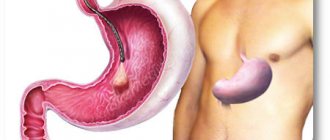GastrituNet.ru » Stomach diseases » Gastritis » Treatment » Diet
Fermented milk products are healthy foods for both healthy people and those with gastrointestinal diseases. But not all fermented milk products are good for an inflamed stomach. How to properly consume products made from sour milk, how much kefir is digested in the stomach, how to choose the right products - we will tell you in our article.
- 1 How long does kefir digest in the human stomach?
- 2 Benefits and harms of fermented milk products for the stomach
- 3 Consumption of kefir for a healthy stomach and for the prevention of diseases
- 4 Consumption of kefir during exacerbation of stomach diseases
- 5 Consumption of kefir during remission
- 6 Features of the lactic acid diet for gastritis and ulcers
- 7 Recipes for dietary dishes with kefir
- 8 Useful video
- 9 Advice from a gastroenterologist
The benefits and harms of fermented milk products for the stomach
Fermented milk products are rich in: Ca, vitamins D, B, A, E, essential microelements, beneficial bacteria. For the stomach, kefir is a valuable lactic acid drink that promotes the proper functioning of the entire body.
Beneficial properties of fermented milk foods:
- rapid recovery after heavy physical activity or illness;
- promotes an increase in red blood cells in the blood;
- a good replacement for animal proteins, which are difficult to digest by a damaged digestive tract;
- has a positive effect on the secretory function of gastric juice;
- normalizes digestive functions.
At the same time, fermented milk and its derivatives can negatively affect the diseased organ.
Negative influence:
- unlimited consumption of fermented milk products can cause indigestion and diarrhea;
- pain in the stomach and intestines, especially when drinking kefir on an empty stomach;
- if food is stored improperly, its consumption can cause poisoning;
- if fermented milk products are consumed after the indicated expiration date, it may cause intestinal upset (constipation, diarrhea).
When digestion is impaired, you should immediately stop taking fermented milk products until the symptoms resolve and the cause is determined.
How much food is digested in the human stomach: table of assimilation of various foods and by age
One of the reasons for excess weight is overeating. It arises due to the fact that few people take into account how much food is digested in the human stomach. As a result, a new portion of food enters the body even before the previous one is disposed of.
This increases the load on many organs and contributes to the formation of fatty deposits. There are many tricks to speed up the digestion of food.
Duration of digestion of food in the human stomach
To be absorbed, complex food compounds must first be broken down into simple molecules. Processing begins in the oral cavity with its mechanical grinding - chewing.
Food undergoes a more active effect in the stomach; its juice contains hydrochloric acid and special enzymes that break down proteins.
Consumption of kefir for a healthy stomach and for the prevention of diseases
For a healthy gastrointestinal tract, you need to drink at least a glass of this valuable drink every day. It has a number of positive effects on a healthy body:
- prevents the proliferation of harmful infectious bacteria;
- stimulates intestinal motility;
- normalizes digestion;
- promotes the removal of waste and toxins from the intestines;
- improves the microflora of the organ mucosa;
- helps strengthen the heart muscle and vascular system;
- accelerates the elimination of bad cholesterol.
Daily consumption of kefir products has a beneficial effect on the replenishment of nutrients in the body, normalizes overall health and prevents the occurrence of gastritis and gastrointestinal ulcers.
How does the body metabolize alcohol?
People are concerned about the question: “How long does ethyl alcohol stay in the blood?” This topic is especially of concern to motorists and those who need to visit a doctor. After all, accurate knowledge of the time of absorption of alcohol and its removal from the body can help solve many problems. There are special tables that show the possible timing of alcohol withdrawal.
Properties of blood after alcohol
When a person takes medications and alcohol, the substances contained in them begin to interact with each other, a chemical reaction occurs in his body, which leads to deterioration of health. Sometimes all it takes is drinking just one glass of champagne.
Alcohol comes into contact with the body through several stages:
- From the stomach, ethyl alcohol enters the blood, and they are completely mixed.
- During the digestion process, oxidation occurs.
- The remaining product is excreted from the body.
After taking ethanol, it is absorbed almost instantly. The process begins in the mucous membrane. The reaction continues in the stomach. Maximum concentration is achieved very quickly. You can get acquainted with its values (how much you need to drink, how long the intoxication lasts) in special digestibility tables.
After alcohol enters the bloodstream, the body quickly tries to reject alcohol from itself. The human liver does a lot of work at this time. How long it takes for the concentration of ethyl alcohol in the blood to decrease can be determined using special tables.
How quickly alcohol is removed from the blood - table
The remaining alcohol, digested and not removed from the body, begins to gradually decompose. Alcohol turns into water and carbon dioxide. Thus, we can safely say that until alcohol overcomes all stages, it will take quite a lot of time. This means that the presence of alcohol in the blood will remain for quite a long time.
Elimination rate criteria
The female body absorbs alcohol much faster than the male body, but the elimination process is 20% slower than in the stronger sex. That is, a woman’s intoxication lasts much longer than a man’s.
A woman doesn’t have to drink a strong drink to get drunk. Simple champagne, which they love so much, is enough. The average strength of this drink is 11%. In other words, one liter contains 11 g of ethyl alcohol.
Alcohol stays in the blood for a certain time, as can be clearly seen from the table. The main factors influencing digestibility are:
- The harm of alcohol on the bodyGender of a person.
- Health status.
- Body mass.
- Amount drunk.
- Taking medications. They can increase or decrease the rate of toxin removal.
- Frequent drinking of alcohol. In the case of constant drinking of alcohol, the absorption time increases significantly.
- Presence of chronic diseases.
- Emotional condition. In case of severe stress, alcohol withdrawal becomes much faster, as metabolism accelerates.
How much alcohol is removed from the body
This is influenced by several very important factors. In the digestibility table, you can determine the amount of alcohol excreted for each state of the body. So, experience can be put in first place when it comes to alcohol withdrawal.
The presence of a certain alcohol content in the blood and how long it takes to be digested in the body are purely individual. But there are also some general nuances. The withdrawal of alcohol and the rate of absorption depend on the time of drinking alcohol and how long such periods lasted.
In principle, this parameter is purely individual, but if we take the general features, we can draw the following conclusion. Alcohol will leave the body much faster if its dose was minimal and alcohol was taken very rarely.
People who constantly drink alcohol and for whom alcohol replaces all other liquids can hardly hope to quickly remove alcohol from the body. The percentage of ethyl alcohol in the blood remains so high that withdrawal can last for weeks.
Emotional condition
It greatly affects the time alcohol remains in the blood. A variety of emotions and our mood affect the rate of absorption and withdrawal of alcohol.
If you had to drink quickly and be very nervous, then digestibility will be practically reduced to zero. Alcohol will not last very long; it will dissipate very quickly. But if it was a long feast, then the alcohol will enter the blood and will be eliminated for several days.
Presence of diseases
Removing alcohol from the blood
It is very difficult to say unequivocally how this or that disease affects the absorption of alcohol. There is no table that would show what kind of chronic disease it is and how it will affect the time of alcohol absorption.
One can only assume that if the body's metabolism is much slower than that of a normal person, the process of eliminating alcohol will also slow down. This can explain why young people sober up much faster than older people.
Individual characteristics
First of all, this concerns ethnicity. In some peoples, resistance to alcohol intake exists at the genetic level. For example, it is enough for Yakuts to drink one glass of alcohol to become very drunk. But the peoples living in the Caucasus are able to drink a large dose of alcohol and not get drunk.
Source: https://alkonavt.net/opyanenie/vyvod-alkogolya/kak-usvaivaetsya-alkogol.html
Consumption of kefir during exacerbation of stomach diseases
If stomach diseases worsen, you should stop taking fermented milk. Drinking kefir with increased acidity of an inflamed stomach is prohibited. Ignoring pain can lead to pathological complications, followed by hospitalization. An acidic drink will irritate and corrode the mucous membranes of the organ, leading to even greater pain and the development of open ulcers.
When eliminating negative symptoms, sometimes a fasting day (fasting) is enough, but in any case, consultation with a doctor is necessary.
It is especially not recommended to drink kefir if you have an erosive disease of the stomach, in which microcracks and ulcers appear on the walls of the mucous membrane.
Consumption of kefir during remission
During the subsidence of the disease, drinking kefir drink is useful, but no more than a glass at a time a couple of times a day.
General recommendations for taking kefir products:
- Do not exceed the permissible volumes of alcohol consumed.
- Use only fresh products.
- The fat content of kefir should be no more than 3%.
- The temperature of the drink should be at room temperature.
- Kefir prepared at home using natural cow's milk is healthier.
Composition and calorie content
Kefir contains a small amount of alcohol, so it is not recommended to be consumed in large quantities by children, those with epilepsy, and even drivers.
The drink is prepared using special fungi. Homemade kefir contains bacteria that are beneficial for the stomach, such as:
- streptococci;
- milk stick;
- acetic bacterium.
The drink has a rich composition, which contains not only minerals and vitamins, but also numerous acids. Proteins, fats and carbohydrates are balanced in kefir, and the drink itself is classified based on the percentage of fat content. On the shelves of modern stores you can find a 1% product, as well as kefir with a fat percentage of 2.5 and 3.25.
If we talk about nutritional value, the drink contains the following components:
- ash;
- water;
- cholesterol;
- monosaccharides and disaccharides.
100 g of product contains 12 g of protein, 23 g of fat, and 16 g of carbohydrates. Thus, the total calorie content is only 53 kcal.
Features of the lactic acid diet for gastritis and ulcers
A healthy fermented milk drink must meet certain requirements for it. The correct choice of kefir products guarantees a positive effect when consumed.
Criteria for choosing a kefir drink:
- The shelf life of the drink should not be more than 5-7 days;
- the contents of the package must have a uniform consistency;
- When purchasing a product, make sure that the container is not damaged;
- It is unacceptable to purchase goods with exfoliated whey;
- Drink no more than two glasses of fermented milk product during the day;
- Take drinks only at room temperature.
If, after drinking kefir, your stomach begins to hurt, it is advisable to go to see a doctor to adjust your diet.
Composition and calorie content
The fermented milk product contains a small amount of alcohol, which is why it is not recommended for use by young children, drivers and people suffering from epilepsy.
The drink is prepared using special kefir grains. The finished product contains a large number of beneficial bacteria: lactic acid bacteria, streptococci containing yeast, acetic acid bacteria and others. In addition, the drink contains:
- vitamins;
- minerals;
- organic acids;
- balanced amount of proteins, fats and carbohydrates.
Kefir is classified mainly by its fat content. Available on sale: low-fat product with fat content of 1%, 2.5% and 3.2%. Nutritional information includes: ash, mono- and disaccharides, saturated fatty acids, cholesterol and water. The calorie content of this fermented milk product can be calculated as follows:
Recipes for dietary dishes with kefir
Plum-honey kefir drink
Ingredients: liter of fermented milk drink, 200 g plums or prunes, 50 g. honey
Cooking technology:
- remove pits from prunes;
- season the fruits with honey, leave for a couple of hours;
- add a couple of teaspoons of the prepared sweet mixture to the drink and drink;
- Serve kefir at room temperature.
Homemade low-fat cottage cheese
Ingredients: milk 2.5% fat, 50 ml. kefir
Cooking technology:
- Combine boiled and cooled milk with kefir, stir thoroughly;
- leave the mixture in the room for 6-9 hours;
- pour the contents into a colander lined with gauze;
- the resulting cottage cheese can be seasoned with raisins, dried apricots, honey, to taste.
Kefir smoothie with zucchini
Ingredients: 200 gr. zucchini without peel, a glass of low-fat fermented milk drink, a teaspoon of honey.
Cooking technology:
- rinse the zucchini, cut into cubes;
- pour kefir liquid into a deep container (liter jar), add honey and chopped vegetables;
- blend with a blender for at least a minute
- Pour the smoothie into a glass and put in a straw.
Homemade cheese
Ingredients: half a liter of kefir, one and a half liters of milk, 2 pinches of salt.
Cooking technology:
- bring the milk to a boil, cool;
- add salt to milk;
- Combine milk and kefir in a saucepan, simmer over low heat for a couple of minutes, stirring constantly;
- pour the resulting brew into a colander lined with gauze and let drain;
- crumple the cottage cheese and put under a press for 2 to 10 hours;
- The longer the cheese is under pressure, the harder it will be.
Creamy soft cheese
Ingredients: kefir or fermented baked milk in any quantity. One liter of product yields approximately 200 grams of cheese.
Cooking technology:
- freeze the fermented milk drink in a container that fits under a colander;
- remove the product from the freezer and place in a colander lined with three layers of thick gauze;
- wait the required amount of time until the product is completely defrosted;
- squeeze out the mass, add salt, sugar, herbs to taste.
Flax drink with sour milk
Ingredients: 200 ml. fermented milk, 2 teaspoons ground flax seed.
Cooking technology:
- Mix sour milk at room temperature with flax seeds crushed in a blender, immediately before drinking the drink.
You should drink the prepared mixture before going to bed. It cleanses the body well, gently removing stagnant waste products of the body from the intestinal tract.
Advice from a gastroenterologist
When asked whether you can drink kefir if you have a stomach ache, experts give a positive answer, but with some limitations, especially with regard to the patient’s diagnosis:
- It is recommended for all people to drink kefir products, but within the limits of what is permitted.
- It is not recommended to use kefir if you have a severe stomach upset.
- The main treatment of gastritis and gastrointestinal ulcers should include dietary nutrition.
- It is advisable not to drink the drink on an empty stomach.
- Any food intake should be limited to small portions, then many problems associated with gastrointestinal disease can be avoided.
- Do not use if the acidic environment of the inflamed organ is elevated.
- Children under 12 months are not recommended to eat kefir foods.
- Individual intolerance precludes acceptance of the product.
Regardless of the diagnosis, it is necessary to eat permitted foods and drink liquids in permitted quantities.
How long does it take to digest?
One of the main advantages of kefir is the speed at which it is digested by the body. The body will need about 30-40 minutes per glass of drink. All its components are quickly absorbed, but at the same time the decay time of the elements included in kefir is reduced. After some time, food begins to be digested 40% faster, thereby saving the necessary energy.
All this became possible thanks to the large amount of carbon dioxide contained in the drink, because it is this that can irritate the walls of the stomach so that it begins to produce more juice.
For the beneficial properties of the drink to be evident, it must be consumed fresh. Only such a drink cannot cause harm, but will help solve many problems of the stomach and intestines. It is especially useful for children and the elderly to include kefir in their diet, as it has a positive effect on the pancreas and liver.
It is best when the product is made independently at home from whole milk, since it contains the maximum amount of essential lactobacilli and vitamins. If you purchase a store-bought product, you should pay special attention to the expiration date. Kefir will only be beneficial if it is fresh.
You will learn more about the benefits of kefir in the following video.
Fermented milk products are healthy foods for both healthy people and those with gastrointestinal diseases. But not all fermented milk products are good for an inflamed stomach. How to properly consume products made from sour milk, how much kefir is digested in the stomach, how to choose the right products - we will tell you in our article.










